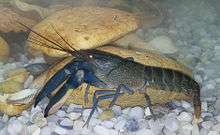Cherax
Cherax is the most widespread genus of fully aquatic crayfish in the Southern Hemisphere. Together with Euastacus, it is also the largest crayfish genus in the Southern Hemisphere. Its members may be found in lakes, rivers and streams across most of Australia and New Guinea.[1] In Australia the many species of Cherax are commonly known as yabbies. The most common and widely distributed species in Australia is the common yabby (Cherax destructor). It is generally found in lowland rivers and streams, lakes, swamps and impoundments at low to medium altitude, largely within the Murray–Darling Basin. Common yabbies are found in many ephemeral waterways, and can survive dry conditions for long periods of time (at least several years) by aestivating (lying dormant) in burrows sunk deep into muddy creek and swamp beds. In New Guinea, Cherax crayfish are found widely in rivers, streams and lakes, with a particularly high diversity in the Paniai Lakes.[2] New Guinea is also home to the only known cave-living crayfish in the Southern Hemisphere, C. acherontis.[3] Some species are very colourful and sometimes seen in the freshwater aquarium trade.[4]
| Cherax | |
|---|---|
.jpg) | |
| Cherax destructor | |
| Scientific classification | |
| Kingdom: | |
| Phylum: | |
| Subphylum: | |
| Class: | |
| Order: | |
| Family: | |
| Genus: | Cherax Erichson, 1846 |
| Type species | |
| Astacus preissii Erichson, 1846 | |
 | |
Species

The genus contains 59 species:[3][5]
- Cherax acherontis Patoka, Bláha & Kouba, 2017
- Cherax albertisii Nobili, 1899
- Cherax albidus Clarke, 1936
- Cherax angustus
- Cherax aruanus Roux, 1911
- Cherax austini Coughran & Hobson, 2012
- Cherax barretti Clark, 1941
- Cherax bicarinatus (Gray, 1845)
- Cherax boesemani Lukhaup & Pekny, 2008
- Cherax boschmai Holthuis, 1949
- Cherax buitendijkae Holthuis, 1949
- Cherax cainii Austin, 2002
- Cherax cairnsensis Riek, 1969
- Cherax cartalacoolah Short, 1993
- Cherax cid Coughran & Furse, 2012
- Cherax communis Holthuis, 1949
- Cherax crassimanus Riek, 1967
- Cherax cuspidatus Riek, 1969
- Cherax davisi Clark, 1941
- Cherax depressus Riek, 1951
- Cherax destructor Clark, 1936
- Cherax dispar Riek, 1951
- Cherax esculus Riek, 1956
- Cherax gherardii Patoka, Bláha & Kouba, 2015[6][7]
- Cherax glaber Riek, 1967
- Cherax glabrimanus Riek, 1967
- Cherax gladstonensis Riek, 1969
- Cherax holthuisi Lukhaup & Pekny, 2006
- Cherax leckii Coughran, 2005
- Cherax longipes Holthuis, 1949
- Cherax lorentzi Roux, 1911
- Cherax minor Holthuis, 1996
- Cherax misolicus Holthuis,1949
- Cherax monticola Holthuis, 1950
- Cherax murido Holthuis, 1949
- Cherax neocarinatus Riek, 1967
- Cherax neopunctatus Riek, 1969
- Cherax nucifraga Short, 1991
- Cherax pallidus Holthuis, 1949
- Cherax paniaicus Holthuis, 1949
- Cherax papuanus Holthuis, 1949
- Cherax parvus Short & Davie, 1993
- Cherax peknyi Lukhaup & Herbert, 2008
- Cherax plebejus (Hess, 1865)
- Cherax preissii (Erichson, 1846)
- Cherax pulcher Lukhaup, 2015[4]
- Cherax punctatus Clark, 1936
- Cherax quadricarinatus (von Martens, 1868)
- Cherax quinquecarinatus (Gray, 1845)
- Cherax rhynchotus Riek, 1951
- Cherax robustus Riek, 1951
- Cherax rotundus Clark, 1941
- Cherax setosus (Riek, 1951)
- Cherax snowden Lukhaup, Panteleit & Schrimpf, 2015[8][7]
- Cherax solus Holthuis, 1949
- Cherax tenuimanus (Smith, 1912)
- Cherax urospinosus Riek, 1969
- Cherax wasselli Riek, 1969
References
- D. H. N. Munasinghe, C. P. Burridge & C. M. Austin (2004). "The systematics of freshwater crayfish of the genus Cherax Erichson (Decapoda: Parastacidae) in eastern Australia re-examined using nucleotide sequences from 12S rRNA and 16S rRNA genes" (PDF). Invertebrate Systematics. 18 (2): 215–225. doi:10.1071/IS03012.CS1 maint: uses authors parameter (link)
- Polhemus; Englund; Allen (2004). "Freshwater Biotas of New Guinea and Nearby Islands: Analysis of Endemism" (PDF). Bernice Pauahi Bishop Museum, Conservation International7.
- Patoka; Blaha; Kouba (2017). "Cherax acherontis (Decapoda: Parastacidae), the first cave crayfish from the Southern Hemisphere (Papua Province, Indonesia)". Zootaxa. 4363 (1): 137–144. doi:10.11646/zootaxa.4363.1.7.
- Agata Blaszczak-Boxe (2015-05-13). "Mysterious beautiful blue crayfish is new species from Indonesia". New Scientist. Retrieved 2015-05-28.
- James W. Fetzner, Jr. (21 May 2015). "Genus Cherax Erichson, 1846". Crayfish Taxon Browser. Carnegie Museum of Natural History. Archived from the original on 2 April 2015. Retrieved 24 November 2015.
- Jiří Patoka, Martin Bláha & Antonín Kouba (2015). "Cherax (Astaconephrops) gherardii, a new crayfish (Decapoda: Parastacidae) from West Papua, Indonesia". Zootaxa. 3964 (5): 526–536. doi:10.11646/zootaxa.3964.5.2. PMID 26249463.CS1 maint: uses authors parameter (link)
- Jiří Patoka, Martin Bláha & Antonín Kouba (2015). "Cherax (Cherax) subterigneus, a new crayfish (Decapoda: Parastacidae) from West Papua, Indonesia". Journal of Crustacean Biology. 35 (6): 830–838. doi:10.1163/1937240x-00002377.CS1 maint: uses authors parameter (link)
- Eliana Dockterman (25 August 2015). "New species of crayfish named after Edward Snowden". TIME. Retrieved 25 August 2015.